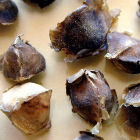Este articulo informa sobre el "Arbol de la Vida, Moringa" de la India que
purifica el agua y su fruto es altamente nutritivo para tratar la desnutricion.
Poor missing out on moringa seeds' water-purifying powers
24 March 2010 | EN

Moringa oleifera seeds can purify water
EcoPort Picture Databank
[OUDTSHOORN] Seeds from a tree that grows widely across the developing world could play a key role in water purification — but there is lack of awareness about this application despite a long indigenous history, say researchers.
The Moringa tree — Moringa oleifera — is native to North India but is also found in Indonesia, Latin America, and Sub-Saharan Africa, and is used in many communities mostly for food and folk medicine.
But adding crushed Moringa seeds to water can cut the time taken for bacteria and solids to settle from a full day to just one hour, and has potential for preventing diarrhoea, according to Michael Lea of Clearinghouse, a Canadian organisation that investigates low-cost water purification technologies.
Lea has published a step-by-step procedure online that shows how the seeds can be crushed to produce a natural flocculant — a substance that aggregates suspended particles.
He hopes that making the technique freely available in this way will facilitate dissemination to those who need it the most — the role of the seeds in purification has been known for centuries but use has been limited.
Writing in Current Protocols in Microbiology, he said that the seeds can provide a low-cost, accessible purification method for poor communities where diarrhoea caused by water-borne bacteria is the biggest killer of children aged five and under.
Lea noted that the seeds "should not be regarded as a panacea for reducing the high incidence of waterborne diseases" — an additional disinfection process is recommended — but can make a valuable contribution to disease reduction.
"Parts of the world have mobile phone and Internet services but no food and potable water," Lea told SciDev.Net. "These trees are indigenous so the solution is in people's backyards. What is required now is knowledge dissemination.
"M. oleifera is the only indigenous treatment technology that addresses poverty and nutrition while also providing potable water."
Lea said that superstition has sometimes limited its use. For instance, in one area of Africa, more than three Moringa trees in a backyard is seen as a source of misfortune that brings poverty and death.
Vallantino Emongor, a M. oleifera expert at the University of Botswana, said: "What is exciting is that this tree is drought resistant and is accessible throughout Africa and India. Communities need to learn what the seeds can do."
Some countries, including Burkina Faso, Benin, Ghana, Ethiopia, Kenya and Uganda, have formed associations to facilitate this.
The Clearinghouse research was published last month (18 February).
Link to full paper in Current Protocols in Microbiology
REFERENCES
Current Protocols in Microbiology doi:10.1002/9780471729259.mc01g02s16 (2010)COMMENTS (3)
Dr.A.Jagadeesh ( Nayudamma Centre for Development Alternatives | India )
24 March 2010
There is another seed STRICNOS POTATORUM which is widely used in rural areas in India to clear the turbidity in water. What people do is to rub the seed with water on a rough surface (like a mud pot piece) and put the paste in turbid water. The turbidity settles down within 30 minutes. Also in Hindu Temples THEERTHAM (Holy water) is preserved for days by putting Ocimum Sanctum(Tulasi Leaves). There are many age old methods which were used by our indigenous people with success. It is the Scientists who should study these methods and synthesise them. Dr.A.Jagadeesh Nellore (AP) India
Dave Wood ( United Kingdom )
30 March 2010
This is old hat. I was asked to collect several species of Moringa in East Africa in the 1970s for trials in Germany on water clearing. The use was based on traditional knowledge. You can also eat the young cooked pods - common in India. We had a tree in our garden in South India. Also Moringa species are very drought tolerant and attractive when in flower and leaf. Let us hope the Convention on Biological Diversity does not stop the movement of these marvellous plants around the world.
anil gupta ( iim and national innovation foundation | India )
11 April 2010
Well old it is, but there is no harm in reinventing old knowledge if it provides low cost affrodable solutions. Question should be asked as to why despite its effectiveness it is not used in public health programes in any developing country on a large scale? It is true that there are a large number of other sources such as jamun tree wood which also purify water. In dhemaji district we came across high content of iron during our 24th shodh yatra and will appreciate any leads on purufying that at low cost.
No comments:
Post a Comment